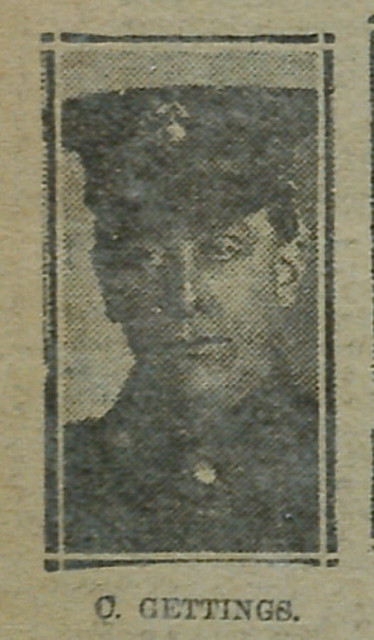L/Cpl
Charles Gettings
Information about birth
|
Date of birth: 29/10/1885 |
|
Place of birth: Crook, Durham, England, United Kingdom |
General information
|
Last known residence: 13 Clavering Ave, Dunston, Durham, England, United Kingdom |
|
Profession: Coal miner |
Army information
|
Country: England, United Kingdom |
|
Force: British Expeditionary Force |
|
Rank: Lance Corporal |
|
Service number: 24/168 |
|
Enlistment place: Newcastle upon Tyne, Northumberland, England, United Kingdom |
|
Units: — Northumberland Fusiliers, 24/27th Bn. (1st Tyneside Irish) (Last known unit) |
Information about death
|
Date of death: 23/10/1917 |
|
Place of death: Requete Farm, Poelcapelle, Belgium |
|
Cause of death: Killed in action (K.I.A.) |
|
Age: 31 |
Memorial
|
Tyne Cot Memorial Panel: 20 A |
Distinctions and medals 2
|
British War Medal Medal |
|
Victory Medal Medal |
Points of interest 4
| #1 | Place of birth | ||
| #2 | Last known residence | ||
| #3 | Enlistment place | ||
| #4 | Place of death (approximate) |
My story
Charles was born late 1885 in Crook, Durham to Thomas and Isabel Gettings. Like his father before him, Charles went to work in the local coalmine. The Gettings’ family was of Irish decent. Charles’ grandparents were immigrants from county Mayo in Ireland. In 1907 Charles married Catherine Graham. They had six children. Two boys and three girls. Their youngest, Isabella, was born five months after Charles was killed in Flanders.
When Charles enlisted, he was taken on by the Northumberland Fusiliers, 24th Bn. (1st Tyneside Irish), a Pals Battalion from Newcastle upon Tyne, largely made up of men from Irish extraction. Due to severe casualties and a shortage of reinforcements the 24th and 27th Battalions were amalgamated in the 24/27th Battalion Northumberland Fusiliers on 9 August 1917.
Early October 1917 the 24/27th Battalion arrived in Flanders. Mid October the Battalion moved into the line, directly north of Poelcapelle. The area allotted to the Tyneside Irish was described as “a country half flooded with water”. The weather may have been cold and wet, but the sector was far from it. In a time span of only 24 hours the 24/27th suffered more than 50 casualties in the line.
The Battalion had been attached to the 102nd Brigade to assist their attack northwest of Poelcapelle. They were to cover the advance of the 18th Division on their right flank. During the attack it became clear that the 18th Division had bypassed the German stronghold at Requette Farm. Charles’ Battalion organised an attack on the farm and the defenders were eventually driven out.
About twenty men were killed during the attack, among them Serjeant Frank Skinnan, and Lance corporal Charles Gettings, two of the remaining original members of the Tyneside Irish Brigade.
Charles has no known grave and is remembered on the Tyne Cot Memorial.
When Charles enlisted, he was taken on by the Northumberland Fusiliers, 24th Bn. (1st Tyneside Irish), a Pals Battalion from Newcastle upon Tyne, largely made up of men from Irish extraction. Due to severe casualties and a shortage of reinforcements the 24th and 27th Battalions were amalgamated in the 24/27th Battalion Northumberland Fusiliers on 9 August 1917.
Early October 1917 the 24/27th Battalion arrived in Flanders. Mid October the Battalion moved into the line, directly north of Poelcapelle. The area allotted to the Tyneside Irish was described as “a country half flooded with water”. The weather may have been cold and wet, but the sector was far from it. In a time span of only 24 hours the 24/27th suffered more than 50 casualties in the line.
The Battalion had been attached to the 102nd Brigade to assist their attack northwest of Poelcapelle. They were to cover the advance of the 18th Division on their right flank. During the attack it became clear that the 18th Division had bypassed the German stronghold at Requette Farm. Charles’ Battalion organised an attack on the farm and the defenders were eventually driven out.
About twenty men were killed during the attack, among them Serjeant Frank Skinnan, and Lance corporal Charles Gettings, two of the remaining original members of the Tyneside Irish Brigade.
Charles has no known grave and is remembered on the Tyne Cot Memorial.
Sources 5
|
24/27 Battalion Northumberland Fusiliers (The National Archives, Kew (TNA), British Army war diaries 1914-1922, WO 95/2467/4). https://www.nationalarchives.gov.uk/ Sources used |
|
Census Returns of England and Wales, 1911 (The National Archives, Kew (TNA), RG14). https://www.nationalarchives.gov.uk/ Sources used |
|
McCarthy, Chris. Passchendaele: the Day-by-Day Account. (Londen: Unicorn Publishing Group, 2018), 138-139. Sources used |
|
Sheen, John. Tyneside Irish. 24th, 25th & 26th & 27th (Service) Battalions of the Northumberland Fusiliers: A Hstory of the Tyneside Irish Brigade raised in the Northeast in World War One. (Barnsley: Pen & Sword Books Limited, 1998), 155-159. Sources used |
|
War Office: Soldiers’ Documents from Pension Claims, First World War (The National Archives, Kew (TNA), WO 364). https://www.nationalarchives.gov.uk/ Sources used |
More information 3
|
Commonwealth War Graves Commission Database https://www.cwgc.org/find-records/find-war-dead/casualty-details/839781 |
|
Namenlijst (In Flanders Fields Museum) https://namenlijst.org/publicsearch/#/person/_id=593bc126-c5c4-4ff8-b527-0c803386450a |
|
Lives of the First World War (Imperial War Museum) https://livesofthefirstworldwar.iwm.org.uk/lifestory/1329931 |
